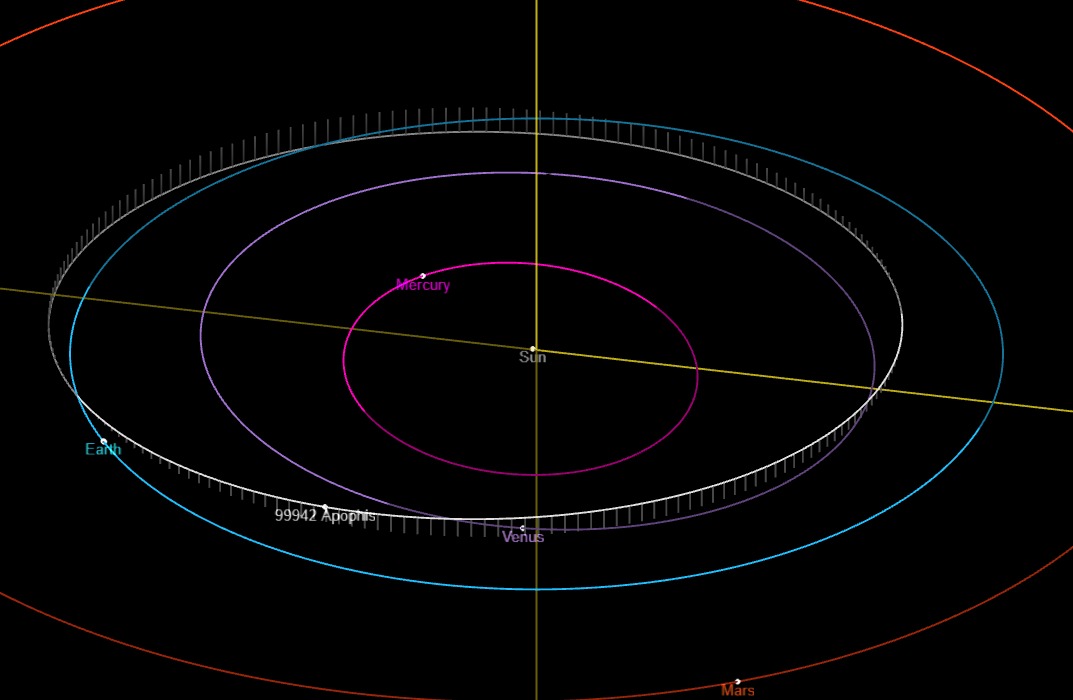Once the primary mission of NASA’s OSIRIS-REx is complete, the spacecraft will head toward a new destination: near-Earth asteroid Apophis.

Heather Roper / University of Arizona
Once an asset is in space and functioning, it only makes sense to repurpose it and obtain the most science bang for the buck. In that vein, NASA announced yesterday that it will grant extensions for eight missions currently underway. While most missions were extended three years, one was extended for nine: The Origins, Spectral Interpretation, Resource Identification, Security, Regolith Explorer (Osiris-REX) spacecraft, which just visited and sampled the asteroid 101955 Bennu and is due to drop off samples at Earth late this year, will continue onward toward another target of opportunity: the potentially hazardous asteroid 99942 Apophis.
The extension will see the mission re-designated as Osiris-APEX (Apophis Explorer). It will encounter Apophis in 2029, shortly before the asteroid's closest Earth approach, and spend the next 18 months exploring the worldlet.
“We were stoked to find out the mission was extended,” says Daniella DellaGiustina (University of Arizona), who was named principal investigator of the extended mission. The spacecraft is uniquely designed for the sort of close rendezvous and imaging that's required. “Our spacecraft is really phenomenal at that,” she adds.
"Osiris-APEX will detect Apophis about three weeks before the asteroid's close encounter with Earth, giving us time to monitor its rotation rate before and after the close encounter," says DellaGiustina. "After that the spacecraft will spend 18 months surveying the asteroid, including going into a close orbit around this small object."
Launched on September 8, 2016, atop an Atlas-V rocket from Cape Canaveral, Osiris-REX reached Bennu in December 2018, and collected samples from the asteroid in October 2020. Now headed back to Earth aboard Osiris, the sample capsule will reenter Earth’s atmosphere on September 24, 2023, over the Air Force’s Utah Test and Training Range.
Research operations at the University of Arizona will split once the sample return capsule departs the main spacecraft, with the Osiris-REX team completing recovery and analysis of the sample, and the Osiris-APEX team managing the continuation toward Apophis. The mission extension adds an additional $200 million to the budget.

NASA Goddard / University of Arizona / Lockheed Martin
Other NASA missions granted extensions include New Horizons and the Lunar Reconnaissance Orbiter, as well as five Martian missions: MAVEN, Mars Odyssey, the Mars Reconnaissance Orbiter, the Curiosity rover, and the InSight lander.
The longest-lived lunar orbiter is going to orbit for even longer! Congratulations to the Lunar Reconnaissance Orbiter team, whose mission was just extended. For nearly 13 years now, LRO's data has transformed our understanding of our Moon. https://t.co/m68M7M1UJA pic.twitter.com/EHj231wBpt
— NASA Moon (@NASAMoon) April 25, 2022
OSIRIS-REX isn't the only mission heading to a second target. The Japanese Hayabusa 2 mission will head to the asteroids 2001 AV43 in 2029 and 1998 KY26 in 2031, respectively, and China’s Chang’e 5 orbiter headed to a new orbit after grabbing samples from the Moon. It will perform solar observations and possibly search for asteroids at the Sun-Earth Lagrange points.
What Do We Know About Apophis?

NASA / JPL
Apophis is a potentially hazardous asteroid, labeled such because its orbit crosses that of Earth. Its discovery back in 2004 caused quite a stir when researchers calculated a small chance it would impact the Earth on April 13, 2029. Later observations refined the orbit and ruled out that possibility, but Apophis will still miss us by just 19,600 miles in 2029, 10 times closer than the Moon and inside geostationary orbit. The 700-meter (1,200-foot) rock will be visible as a 3rd-magnitude moving “star” from Europe, Africa, and western Asia.
Osiris-APEX’s close-up look will tell us if Apophis is a loose rubble-pile like Bennu, or something more substantial. Apophis is known from spectral analysis to be an S-type chondrite, versus the B-type carbonaceous chondrite Bennu, so it should provide some contrast for study. Scientists also plan to use the spacecraft’s gas thrusters to attempt to dislodge and study the dust and small rocks on and below Apophis’s surface.
"Apophis' bulk structure and surface strength have important implications for planetary defense," says DellaGiustina. "As a 'stony' S-type asteroid, Apophis represents the most common class of potentially hazardous asteroids and knowledge of its properties can inform planetary defense mitigation strategies."

University of Arizona / JPL / Arecibo
These future plans were announced right after the release of the Planetary Science Decadal Survey last week, which specifically mentioned the possibility of exploring Apophis. We’re truly entering in the age of asteroid exploration now, as we are for the first time getting multiple close-up views of these tiny worlds.
 1
1









Comments
Anthony Barreiro
April 26, 2022 at 7:08 pm
Perhaps we shouldn't use the phrase "bang for the buck" in the same sentence with a potentially hazardous asteroid, but these little robotic missions sure do give a huge return on investment! A robot is orders of magnitude cheaper than a crewed mission, and the robots keep going without complaint for years and decades, whereas we need to get humans back to Earth pretty quickly before the rigors of space kill them.
Just send robots!
You must be logged in to post a comment.
You must be logged in to post a comment.